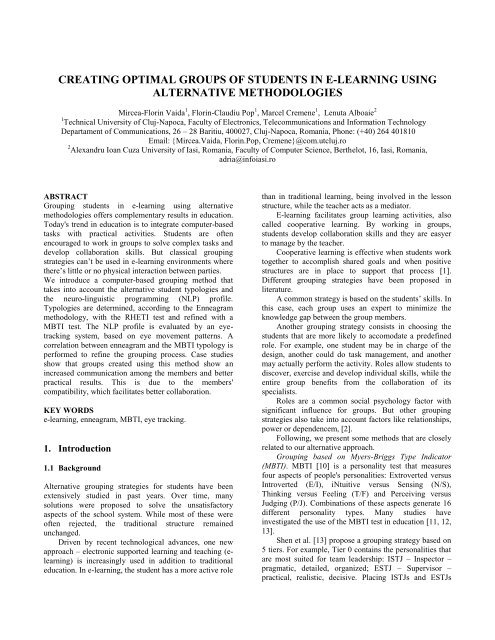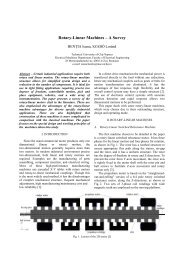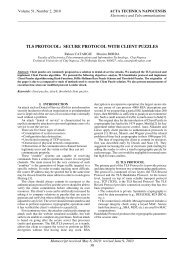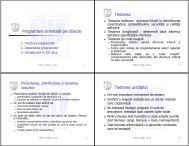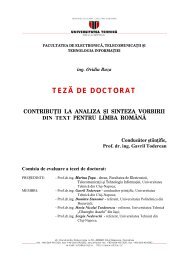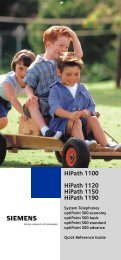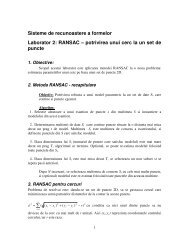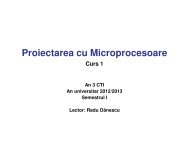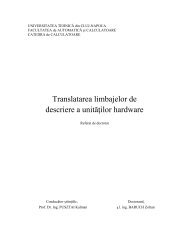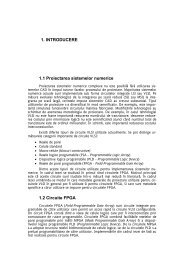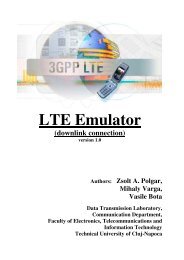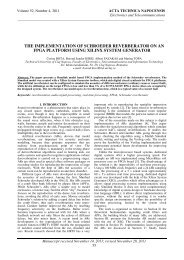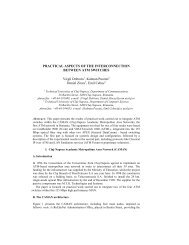CATE2011_734_008_Enneagram_MBTI.pdf
CATE2011_734_008_Enneagram_MBTI.pdf
CATE2011_734_008_Enneagram_MBTI.pdf
Create successful ePaper yourself
Turn your PDF publications into a flip-book with our unique Google optimized e-Paper software.
CREATING OPTIMAL GROUPS OF STUDENTS IN E-LEARNING USING<br />
ALTERNATIVE METHODOLOGIES<br />
Mircea-Florin Vaida 1 , Florin-Claudiu Pop 1 , Marcel Cremene 1 , Lenuta Alboaie 2<br />
1 Technical University of Cluj-Napoca, Faculty of Electronics, Telecommunications and Information Technology<br />
Departament of Communications, 26 – 28 Baritiu, 400027, Cluj-Napoca, Romania, Phone: (+40) 264 401810<br />
Email: {Mircea.Vaida, Florin.Pop, Cremene}@com.utcluj.ro<br />
2 Alexandru Ioan Cuza University of Iasi, Romania, Faculty of Computer Science, Berthelot, 16, Iasi, Romania,<br />
adria@infoiasi.ro<br />
ABSTRACT<br />
Grouping students in e-learning using alternative<br />
methodologies offers complementary results in education.<br />
Today's trend in education is to integrate computer-based<br />
tasks with practical activities. Students are often<br />
encouraged to work in groups to solve complex tasks and<br />
develop collaboration skills. But classical grouping<br />
strategies can’t be used in e-learning environments where<br />
there’s little or no physical interaction between parties.<br />
We introduce a computer-based grouping method that<br />
takes into account the alternative student typologies and<br />
the neuro-linguistic programming (NLP) profile.<br />
Typologies are determined, according to the <strong>Enneagram</strong><br />
methodology, with the RHETI test and refined with a<br />
<strong>MBTI</strong> test. The NLP profile is evaluated by an eyetracking<br />
system, based on eye movement patterns. A<br />
correlation between enneagram and the <strong>MBTI</strong> typology is<br />
performed to refine the grouping process. Case studies<br />
show that groups created using this method show an<br />
increased communication among the members and better<br />
practical results. This is due to the members'<br />
compatibility, which facilitates better collaboration.<br />
KEY WORDS<br />
e-learning, enneagram, <strong>MBTI</strong>, eye tracking.<br />
1. Introduction<br />
1.1 Background<br />
Alternative grouping strategies for students have been<br />
extensively studied in past years. Over time, many<br />
solutions were proposed to solve the unsatisfactory<br />
aspects of the school system. While most of these were<br />
often rejected, the traditional structure remained<br />
unchanged.<br />
Driven by recent technological advances, one new<br />
approach – electronic supported learning and teaching (elearning)<br />
is increasingly used in addition to traditional<br />
education. In e-learning, the student has a more active role<br />
than in traditional learning, being involved in the lesson<br />
structure, while the teacher acts as a mediator.<br />
E-learning facilitates group learning activities, also<br />
called cooperative learning. By working in groups,<br />
students develop collaboration skills and they are easyer<br />
to manage by the teacher.<br />
Cooperative learning is effective when students work<br />
together to accomplish shared goals and when positive<br />
structures are in place to support that process [1].<br />
Different grouping strategies have been proposed in<br />
literature.<br />
A common strategy is based on the students’ skills. In<br />
this case, each group uses an expert to minimize the<br />
knowledge gap between the group members.<br />
Another grouping strategy consists in choosing the<br />
students that are more likely to accomodate a predefined<br />
role. For example, one student may be in charge of the<br />
design, another could do task management, and another<br />
may actually perform the activity. Roles allow students to<br />
discover, exercise and develop individual skills, while the<br />
entire group benefits from the collaboration of its<br />
specialists.<br />
Roles are a common social psychology factor with<br />
significant influence for groups. But other grouping<br />
strategies also take into account factors like relationships,<br />
power or dependencem, [2].<br />
Following, we present some methods that are closely<br />
related to our alternative approach.<br />
Grouping based on Myers-Briggs Type Indicator<br />
(<strong>MBTI</strong>). <strong>MBTI</strong> [10] is a personality test that measures<br />
four aspects of people's personalities: Extroverted versus<br />
Introverted (E/I), iNtuitive versus Sensing (N/S),<br />
Thinking versus Feeling (T/F) and Perceiving versus<br />
Judging (P/J). Combinations of these aspects generate 16<br />
different personality types. Many studies have<br />
investigated the use of the <strong>MBTI</strong> test in education [11, 12,<br />
13].<br />
Shen et al. [13] propose a grouping strategy based on<br />
5 tiers. For example, Tier 0 contains the personalities that<br />
are most suited for team leadership: ISTJ – Inspector –<br />
pragmatic, detailed, organized; ESTJ – Supervisor –<br />
practical, realistic, decisive. Placing ISTJs and ESTJs
within the same group, due to the inherent potential for a<br />
power struggle to develop, is not advised.<br />
Amato et al. [12] use Myers-Briggs personality<br />
profiles to evaluate the consistence and the progress of a<br />
group. She classifies groups containing similar<br />
personalities as compatible and groups that “blend<br />
individuals with different talents and preferences” as<br />
complementary. She finds that students with no prior<br />
group experience prefer compatible groups due to the<br />
comfort of such a structure, while students with<br />
experience prefer complementary groups where their<br />
talent is valued.<br />
Grouping based on the learning strategy. F. Tian et<br />
al. [14] propose a grouping method based on a fuzzy<br />
analysis of student personalities and their learning<br />
strategies. They use an extension of Raymond Cattell's 16<br />
Personality Factors [15] model to determine a student’s<br />
personality and learning strategy. When grouping<br />
students, the fuzzy algorithm ensures that students with<br />
common learning characteristics are part of the same<br />
cluster. This way they can better collaborate and improve<br />
their skills.<br />
1.2 Problem statement and approach<br />
This paper extends our previous results [16], and<br />
addresses the problem of student grouping in e-learning,<br />
where little or no physical interaction takes place between<br />
the teacher and his students. Given these circumstances,<br />
we can only rely on the computer for analyzing the<br />
psychologycal and technical profile of the students.<br />
The goal is to divide the class of students into groups<br />
and assign roles accordingly, in order to maximize the<br />
efficiency for team-based projects.<br />
To achieve this, we first observe the students during<br />
individual practical activities, using our e-learning<br />
environment. This consists of a Content Management<br />
System (CMS) and an eye tracking system [3]. The eye<br />
tracking system, not only provides assistance when a<br />
student has difficulties in following a visual presentation,<br />
but is also able to detect some aspects of a student’s<br />
personality (e.g. predisposition to visual elements, audio<br />
elements, spoken communication etc.). These aspects<br />
define the NLP (Neuro-Linguistic Programming) profile<br />
of a student.<br />
In the next step, we use the RHETI (Riso-Hudson<br />
<strong>Enneagram</strong> Type Indicator [4]) test, to determine the<br />
students enneagram typologies and a <strong>MBTI</strong> test to<br />
determine the corresponding typology [10]. A correlation<br />
between enneagram and the <strong>MBTI</strong> typology is performed<br />
to refine the grouping process. Finally, we divide the class<br />
into groups and assign roles, considering the typologies<br />
and the NLP profiles.<br />
The grouping strategy we use is based on typology<br />
compatibilities, which are a result of the psychological<br />
interpretation of the <strong>Enneagram</strong>. Some typologies prove<br />
to show better progress if connected to their psychological<br />
complement. Members of such groups achieve better<br />
results than members of groups that don’t take into<br />
account the personality factor or the compatibilities<br />
between personalities [5].<br />
1.3 Outline<br />
This paper is organized as follows: the next section details<br />
the personality factors considered for our solution, section<br />
3 describes the proposed grouping strategies, results are<br />
discussed in section 4, while section 5 provides some<br />
conclusions of our work.<br />
2. Personality factors<br />
2.1 The <strong>Enneagram</strong> of Personality<br />
The <strong>Enneagram</strong> of Personality (known as the <strong>Enneagram</strong>)<br />
is used in a variety of contexts, including business,<br />
psychotherapy, spiritual development work, art and<br />
education. It is an application of the <strong>Enneagram</strong> figure in<br />
connection with personality features, including nine main<br />
typologies (Fig. 1).<br />
The points on the <strong>Enneagram</strong> figure indicate a<br />
number of ways in which nine principal ego-archetypal<br />
forms, or types of human personality, called Enneatypes,<br />
are psychologically connected. Enneatypes are referred to<br />
by different names, or more general by numbers. These<br />
are some of the variations (Fig.1 b):<br />
a.<br />
b.<br />
1. Perfectionist, Reformer<br />
2. Helper, Giver<br />
3. Performer, Producer, Achiever<br />
4. Tragic Romantic, Individualist,<br />
Connoisseur<br />
5. Observer, Investigator, Sage<br />
6. Devil's Advocate , Loyalist,<br />
Troubleshooter, Guardian<br />
7. Epicure, Enthusiast, Visionary,<br />
Dreamer, Generalist<br />
8. Boss, Top Dog, Challenger, Confronter<br />
9. Mediator, Peacemaker, Preservationist<br />
Fig. 1. <strong>Enneagram</strong> and Typologies<br />
Each Enneatype (chief feature) corresponds to a<br />
distinctive and habitual pattern of thinking and emotions.<br />
The Enneatype of an individual can be determined using<br />
the RHETI (Riso-Hudson <strong>Enneagram</strong> Type Indicator)<br />
test, which contains 144 paired statements.<br />
Based on the Enneatypes, different strategies can be<br />
considered to define working groups of students (or any<br />
other types).<br />
Ideally, when all 9 Enneatypes manifest within a<br />
group, the members’ evolution is more rapid. But it’s<br />
possible to have a group with a limited number of<br />
typologies, less than 9. In this case, the unity, cohesion<br />
and communication are very important.
Our aim is to create a harmonious group where<br />
members with compatible Enneatypes can easily<br />
collaborate and obtain valuable results. But only<br />
typologies are not sufficient for assigning roles to the<br />
group members.<br />
2.2 <strong>MBTI</strong> and <strong>Enneagram</strong> methodologies<br />
The <strong>MBTI</strong> and <strong>Enneagram</strong> are two different personality<br />
typologies. As alternative methodologies they work well<br />
when are used in conjunction [17].<br />
<strong>MBTI</strong> was developed in the early 1940's by Myers<br />
& Briggs that extended Jung's model. The model looks at<br />
the conscious functions of taking in information through<br />
the functions of Sensing and Intuition and making<br />
decisions through Thinking or Feeling. <strong>MBTI</strong> model is<br />
very accessible and therefore most often practiced. <strong>MBTI</strong><br />
literature focuses on the positive or more neutral aspects<br />
of the types before considering a stress situation.<br />
The <strong>Enneagram</strong> has an esoteric history based on<br />
ancient civilizations. It dates back before the mystic<br />
schools of Islam and from ancient Greek civilization<br />
using “Tetraktis” as a Pythagorean symbol. The Sufis,<br />
Greeks, Cabalists used aspects of the <strong>Enneagram</strong> in the<br />
spiritual development of initiates. The <strong>Enneagram</strong> looks<br />
how the 9 different typologies influence our orientation to<br />
the world. The <strong>Enneagram</strong> model is considered as focused<br />
to the shadow aspects of personality. As real world<br />
applications of the <strong>Enneagram</strong> model we have<br />
orientations for business and self-development.<br />
A mapping between <strong>MBTI</strong> typologies and Enneatypes<br />
Different mappings from <strong>MBTI</strong> to <strong>Enneagram</strong> are<br />
presented in literature. There isn’t a direct correlation<br />
accepted, but there are some things that may be typical<br />
however given the understanding that there is an<br />
exception to every one of these forced correlations. A<br />
possible correspondence can be [19]:<br />
<strong>Enneagram</strong> 1 and I*TJ<br />
<strong>Enneagram</strong> 2 and E*FJ<br />
<strong>Enneagram</strong> 3 and E*TP<br />
<strong>Enneagram</strong> 4 and INFJ<br />
<strong>Enneagram</strong> 5 and I*TP<br />
<strong>Enneagram</strong> 6 and ISFJ<br />
<strong>Enneagram</strong> 7 and E*FP<br />
<strong>Enneagram</strong> 8 and E*TJ<br />
<strong>Enneagram</strong> 9 and I*FP<br />
Some authors and researchers have mapped this even<br />
more extensively than these limited correlations, [17],<br />
[18].<br />
The correspondence between Enneatypes and <strong>MBTI</strong><br />
types helps to refine the grouping process.<br />
2.3 Correlating eye movement patterns with<br />
personality features<br />
Using NLP (Neuro-Linguistic Programming), it is<br />
possible to classify the persons based on some specific<br />
characteristics of eye movement patterns in different<br />
structures [6]. If we are able to determine the predominant<br />
pattern for a person, we can send a message that is<br />
adapted and suited for that person.<br />
The visual structure is representative for persons that<br />
are sensible to visual materials, graphics, images, etc.<br />
Such a person will have a precise ocular movement based<br />
on a moment attitude. When they think, they will raise the<br />
eyes having a visual contact.<br />
The auditory structure is based on hearing. Persons<br />
in this category are sensible to sound effects, noise and<br />
voice tonality. When they are looking for something, their<br />
eyes go to the left or right side.<br />
The sensitive structure includes persons that are<br />
sensible to extra verbal communication. A down<br />
movement of eyes when they communicate and a leftright<br />
movement is characteristic to them.<br />
Not as a specific structure, but as a combination of<br />
different structures are the kinesthesia persons. The<br />
general movement and the need for space is their<br />
characteristic. When they speak they are moving and the<br />
action memory is very important. The eyes have no<br />
precise movement. So an up, down, left and right<br />
movement appears during the person activity.<br />
3. Proposed grouping strategy<br />
3.1 Scenario<br />
We use e-learning for teaching software-related<br />
disciplines: Basic Object Oriented Programming,<br />
Software Engineering in Telecommunications at licencese<br />
level, and Advanced Elements to Develop Software in<br />
Telecommunications at master level. Each course is<br />
followed by practical learning activities.<br />
The first part of each module is dedicated on making<br />
students familiar with the technologies used for the<br />
practical activities. We take advantage of this<br />
accommodation period and observe the students. This<br />
observation done by the eye tracking system they use to<br />
follow the theoretical aspects and by the teacher who<br />
conducts the practical activities.<br />
At the middle of the semester, the students need to<br />
be assigned to working groups. Each working group is<br />
given a project, which is evaluated at the end of the<br />
semester. Within the group, each student plays a welldefined<br />
role. Being a software project, the roles we<br />
support are: manager, designer, analyst, programmer,<br />
tester and technical writer. Not all groups can have a<br />
manifestation of each role, due to the limited number of<br />
members.<br />
Such a scenario raises two questions regarding<br />
student grouping: 1) What is the best grouping strategy<br />
that maximizes the students’ potential in solving the<br />
required task? 2) If efficient grouping requires knowledge<br />
about one’s personality, how can such knowledge be<br />
acquired by a computer?
First, we approach the second problem. We<br />
determine two features for each student (Fig. 2):<br />
1. The NLP profile N. The eye tracking system does<br />
this, while the student is using the e-learning<br />
environment during the first part of the module.<br />
2. The typology T, according to the <strong>Enneagram</strong>. The<br />
typology is evaluated using the RHETI test, which<br />
students take before the group assignment and is<br />
refined with a <strong>MBTI</strong> test.<br />
Given the feature set (T, N), the grouping strategy is a<br />
function from (T, N) to (G, R). This process is detailed at<br />
the end of this section.<br />
Fig. 2. The grouping process<br />
3.2 The e-learning platform<br />
The massive penetration of mobile computing is reflected<br />
by the fact that almost every student nowadays owns a<br />
laptop. Also, due to the evolving communications needs,<br />
most laptops are fitted with an integrated webcam. We<br />
use this widely available technology to implement a<br />
student-centered e-learning solution.<br />
Students use their laptops to follow course<br />
material presentations. During the course, some areas of<br />
each slide capture the attention of certain students. This is<br />
measured by analyzing their eye movements, captured by<br />
integrated webcams. When difficulty (manifested through<br />
an increased interest over some elements of the visual<br />
scene) is detected, it is recorded and the student is<br />
automatically shown supplementary explanations. If more<br />
students encounter the same issue, the teacher is notified<br />
so that he can insist on explaining it to the students. At the<br />
end of the class, a report is generated based on the<br />
recorded difficult sections for later review.<br />
The e-learning platform has two components,<br />
corresponding to the two parties involved in the learning<br />
process (Fig. 3):<br />
Learning assistant – intended to help the course<br />
attendants by tracking their progress and providing<br />
computer assistance<br />
Teaching assistant – used by the course owner to<br />
supervise the learning process.<br />
The Learning assistant relies on the webcam to<br />
evaluate the subject's reaction for the visual scene.<br />
Roughly, the visual scene is composed of text regions and<br />
images. These elements are called Regions of Interest<br />
(ROI). A typical reaction to a text region is to read the<br />
entire text and focus on the elements that are new to the<br />
subject or are intentionally marked as important (i.e. some<br />
words in bold). Behavior that can be associated with<br />
learning difficulty consists of longer focus on certain<br />
areas of the visual scene or an irregular reading pattern.<br />
The eye-tracking component of the Learning assistant is<br />
based on the Machine Perception Toolbox (MPT)<br />
framework [7], which supplies cross-platform libraries for<br />
real-time perception primitives, including face detection,<br />
eye detection, blink detection, color tracking. MPT<br />
provides support for eye detection, which we used to<br />
implement real-time eye tracking.<br />
Fig. 3. e-learning platform architecture<br />
Figure 4 shows the eye-tracking window where the<br />
face is delimited by a white rectangle and the eyes are<br />
marked with two smaller rectangles. The eye-tracking<br />
engine evaluates the eyes position for every frame,<br />
eliminates the aberrant values, and averages the<br />
normalized consistent values every 15 frames.<br />
Normalization is done by taking into account the head<br />
position in the video frame. Resulting values are sent to<br />
the scene tracking component for analysis.<br />
Fig.4. Eye tracking and scene tracking<br />
Identifying the important elements to the subject is<br />
called scene tracking. In the process of scene tracking, the<br />
subject’s gaze needs to be translated into a ROI. First, we<br />
evaluate the fixation count for each element in the scene,<br />
and then we select the elements above a certain threshold.<br />
Each course slide is apriori annotated by the knowledge<br />
processor and the position of a ROI on the screen is<br />
known. Therefore, we only take into account the fixations<br />
that fall over such elements and ignore the rest.
Scene tracking often identifies more than one<br />
element. Because there’s a limited amount of time the<br />
student is facing one scene, we need to pick the most<br />
important elements of the scene. We call this selection of<br />
elements interest tracking.<br />
For simplification, we pick the first most focused<br />
element by the subject. This is the student’s main interest<br />
regarding the visual scene. The element of interest is then<br />
sent to the Teaching assistant for statistical processing.<br />
Based on the interest sent, a response is received in the<br />
form of new knowledge – extra information related to the<br />
scene’s most observed element.<br />
The Teaching assistant is a CMS intended to host and<br />
manage the information transmitted to the students during<br />
the learning process. First, the teacher creates the course<br />
materials. The course flow resembles a typical<br />
presentation, slide by slide.<br />
The knowledge processor is the automatic process<br />
that does ROI identification and tagging. It analyzes the<br />
content and breaks it into knowledge units. Each<br />
knowledge unit can be a text block or an image.<br />
Text blocks are split into text segments and stop<br />
words are removed. Each text segment is linked to its<br />
semantically similar terms. The semantic analysis uses a<br />
dictionary called WordNet [8] to search for synonyms.<br />
Images are added a semantic description.<br />
The semantic information about the visual scene is<br />
used as search patterns by the interactive knowledge<br />
module. We use Wikipedia as a source for new<br />
knowledge. When a search pattern links to a Wikipedia<br />
page, that page is sent to the Learning assistant as new<br />
knowledge based on subject’s interest.<br />
A video demonstration of our e-learning platform can<br />
be found at http://mercur.utcluj.ro/eyetracking/<br />
3.3 Student grouping<br />
When creating groups of students we want to maximize<br />
the positive interactions between the group members. This<br />
can be done if we take into account the compatibilities<br />
between the group members. In other words, we want to<br />
have all nine Enneatypes to manifest as complementary<br />
aspects.<br />
The manifestation of all typologies can be realized<br />
considering a limited number of members, less than nine,<br />
but with specific interactions. A group needs to have at<br />
least three members in order to achieve an optimum<br />
structure (the three’s law).<br />
One strategy may consider that the <strong>Enneagram</strong> is<br />
organized in three triads (Fig. 5), and the Enneatypes in<br />
each triad are thought to share similar characteristics.<br />
Rohr refers to these as the Gut, Heart, and Head triads [9].<br />
Theoretically, one of these areas predominates in each of<br />
us. An optimal group structure needs to have at least one<br />
representative from each triad, but not any representative.<br />
Gut-people are known to be direct, territorial,<br />
concerned with power, ruled by aggression. Their<br />
predominant emotion is anger and their mind may be<br />
troubled by ethical self-doubts and self-blame. They act<br />
instinctively, spontaneously and intuitively.<br />
Heart-people are ruled by feelings. They are often<br />
concerned with what others think of them, seeing<br />
themselves as being for others and often believing they<br />
know what's best for them. Their predominant emotion is<br />
anxiety, they dislike being alone, may feel sad and<br />
ashamed.<br />
Head-people are methodical and orderly, detached<br />
from their emotions. They try to apprehend every<br />
situation, understand the pattern of events and their place<br />
within it. Their predominant emotion is fear.<br />
The grouping process starts with identifying the<br />
Chief Feature. This can be a base <strong>Enneagram</strong> type<br />
(Enneatype), or a combination of two adjacent types, as,<br />
for example, Four and Five. This combination can be<br />
regarded as a subtype. The types on each side of the Chief<br />
Feature are called wings (Three and One are wings for<br />
Two). In case of a subtype, one wing is the weaker type of<br />
the two composing the subtype.<br />
Each Enneatype is connected with two other types, in<br />
different triads. The connection is marked with a path<br />
(line) in the <strong>Enneagram</strong> representation. For example Nine<br />
is connected to Three and Six. These connections show<br />
how one Enneatype behaves under integrative (growth) or<br />
disintegrative (stress) conditions. The integrative /<br />
disintegrative behavior follows the directions shown in<br />
Figure 5. For example, under stress Nine will behave like<br />
a Six, while in growth will behave like a Three.<br />
We considered in our research one base typology<br />
(Chief Feature), one typology on the integration direction<br />
and one typology on the disintegration direction, Fig. 5. In<br />
this way it is possible to define efficient groups using a<br />
general <strong>Enneagram</strong> test and an adequate interpretation.<br />
Such groups have a representative from each <strong>Enneagram</strong><br />
triad, which complete each other.<br />
Fig. 5. <strong>Enneagram</strong> triads, integration/disintegration directions<br />
The ideal group structure will have members with<br />
typologies 3, 6 and 9. Other possible grouping typologies<br />
are: (1, 7, 4), (2, 4, 8), (4, 1, 2), (5, 8, 7), (7, 5, 1), (8, 5,<br />
2), using 1, 2, 4, 5, 7 and 8 as Chief Feature.<br />
The use of Enneatypes for the group structure ensures<br />
the typology diversity. In this moment some refinements<br />
where introduced based on the corresponding <strong>MBTI</strong><br />
typologies.<br />
But this is not sufficient if we want to maximize the<br />
success of a group. In order to do this, we combine the
<strong>Enneagram</strong> rule with the NLP profiles determined by the<br />
eye tracking system to obtain groups with representative<br />
figures from each NLP structure: visual, audio, sensitive,<br />
and kinesthesia.<br />
4. Results<br />
Case studies were conducted over a period of more years<br />
with students in their first and third year of Bachelor of<br />
Science classes, and the students in the first year of<br />
Master of Science. Students were observed during the<br />
practical activities of the Basic Object Oriented<br />
Programming with C++ and Software Engineering<br />
courses for bachelors and for Advanced Elements to<br />
Develop Software in Telecommunications at the masters.<br />
Each practical activity class consisted of two stages: a<br />
documentation stage, when the students were presented a<br />
summary of the theoretical aspects and a working stage,<br />
when the students put in practice what they learned.<br />
The first part of each semester is dedicated on<br />
observing the students. This observation done by the eye<br />
tracking system they use to follow the theoretical aspects<br />
and by the teacher who conducts the practical activities.<br />
At the middle of the semester, the students take the<br />
RHETI and <strong>MBTI</strong> test and are assigned to working<br />
groups according to the proposed strategy. Each working<br />
group is assigned a project, which is evaluated at the end<br />
of the semester.<br />
Each year, we apply this method on half the<br />
students, while the other half are grouped using the skillbased<br />
strategy (one expert in each group). These students<br />
are used as a reference to compare the results.<br />
The first part of the group project consists in creating<br />
a “Task notebook” based on the specifications. Then, the<br />
group will divide the main tasks to each member and in<br />
the “External/Internal Reunion meetings” the drawbacks<br />
will be clear specified and analyzed. Any new proposed<br />
solution will not be rejected being criticized, and if<br />
possible, a new solution will be chosen in the meeting.<br />
This practice encourages the creativity and originality.<br />
The Internal Reunions include only the group members,<br />
while the External Reunion requires the presence of the<br />
teacher. The final result is a “Specification Notebook” and<br />
the implementation of the product.<br />
Mental connections that are feature the development<br />
of new technical solutions are not limited to the classical<br />
standard solutions. Group meetings are intended to<br />
stimulate brainstorming.<br />
During their work on the project all the groups were<br />
suggested to use the brainstorming technique. Group<br />
brainstorming is effective when all members share their<br />
experience and creativity.<br />
The total number of working groups observed during<br />
our experiments was 61. Out of these team groups, only<br />
about half accepted to use the brainstorming technique to<br />
develop projects (during the case study period, the<br />
technique was optional).<br />
At the end of the experiments, three aspects were<br />
relevant:<br />
1. Members of teams that were grouped based on<br />
compatibility typologies using enneatypes and <strong>MBTI</strong><br />
showed better improvement, not in terms of acquired<br />
knowledge in particular, but in terms of learning how<br />
to combine knowledge with creativity. In about 25%<br />
of the brainstorming groups the evolution was<br />
spectacular.<br />
2. Members of teams assigned using the proposed<br />
strategy proved to communicate more than members<br />
of classical teams. Communication featured<br />
brainstorming and all these aspects manifested in<br />
making the group more productive.<br />
3. The developed products were original, full of<br />
creativity and more reliable.<br />
As examples of some projects topics developed by the<br />
2010-2011 Master of Science students we mention:<br />
-Organic computing<br />
-Workflow foundation based on Microsoft<br />
technologies<br />
-Workflow application- PassFlow with Oracle BPMN<br />
Suite<br />
-UML design<br />
-HMI based on biometry<br />
-Basic software testing<br />
-Software testing – new methodologies<br />
-HCI - FriendlyPC<br />
-HCI - SpeachInteraction<br />
Figure 6 presents the user interface of one of these<br />
projects.<br />
Fig. 6. HCI – FriendlyPC<br />
Another experiment was conducted during the<br />
summer first year students’ internship at the Cluj-Napoca<br />
subsidiary of Wirtek, a Danish software company. Three<br />
rounds of internship stages were scheduled, while each<br />
internship stage took three weeks. Twelve students were<br />
admitted for each stage and they were grouped in two<br />
teams.
The internship was focused on developing software<br />
projects considering new technologies in C# and Java.<br />
The first round included the best students. They were<br />
grouped considering preferences, in the teams dividing<br />
process. The second round of students was divided<br />
considering an <strong>Enneagram</strong> methodology and was<br />
composed by students with lower software skills. The<br />
third round was grouped in accordance with some<br />
personality criteria established by the software company.<br />
The final evaluation, done by the software company<br />
analyzed obtained technical abilities, general training<br />
responses and team collaboration abilities.<br />
The first set of students obtained the best technical<br />
results with a linear evolution. The collaboration process<br />
during the teams was limited, each student working on<br />
dedicated tasks.<br />
The second set started with huge difficulties<br />
considering technical abilities. The compatibilities of the<br />
members from the teams helped them to evolve in an<br />
exponential mode. The final evaluation revealed very<br />
promising results for acquired technical abilities and the<br />
relations among the members were very opened and<br />
harmonious.<br />
In the third set, the teams were created based on the<br />
company’s criteria, which involved five personality types.<br />
The final evaluation concluded that the second set of<br />
students showed better improvement than the first and<br />
third set, in terms of technical skills and social interaction.<br />
5. Conclusion<br />
In this paper, we propose a grouping strategy for elearning<br />
environments, where there’s little or no physical<br />
interaction between the teacher and its students. But<br />
effective grouping strategies take into account personality<br />
factors, which are hard to evaluate by a computer.<br />
Since our e-learning platform features an eye tracking<br />
solution, we use this to create a student’s neuro-linguistic<br />
programming (NLP) profile, while he is actively using it.<br />
Another original aspect of our work is the use of<br />
typologies, determined according to the <strong>Enneagram</strong><br />
methodology, with the RHETI test. A refinement is<br />
considered based on a <strong>MBTI</strong> test.<br />
Groups are composed of 3 members, of compatible<br />
typologies. Compatibilities are according to the<br />
integrative and disintegrative directions on the<br />
<strong>Enneagram</strong>. This also ensures that each group has a<br />
member from each <strong>Enneagram</strong> triad. The NLP profile also<br />
plays a role in the group structure, as each group needs to<br />
have a representative of each defined profile.<br />
We conducted case studies to test our solution over<br />
more years, with students with different levels of group<br />
work experience. Our results show that groups created<br />
using this method perform better than groups that don’t<br />
take into account the personality factor, in terms of selfdevelopment<br />
and group communication.<br />
During the work on their assignment, all the groups<br />
were suggested to use the brainstorming technique.<br />
Members of groups that used brainstorming showed better<br />
improvement, not in terms of acquired knowledge in<br />
particular, but in terms of learning how to combine<br />
knowledge with creativity.<br />
Acknowledgement(s)<br />
This work was supported by the national project code TE<br />
252 financed by the Romanian Ministry of Education and<br />
Research CNCSIS-UEFISCSU.<br />
References<br />
[1] Johnson, D. W., Johnson, R. Learning together and<br />
alone: Cooperative, competitive, and individualistic<br />
learning. (Boston: Allyn & Bacon. First edition, 1975)<br />
[2] Thibaut, J., Kelley, H. The social psychology of<br />
groups (Transaction Publishers, 1896)<br />
[3] Pop, F.-C., Vaida, M.-F. Adaptable learning using eye<br />
tracking. Digital Learning India 2009, the 5th annual<br />
conference, eIndia2009, Hyderabad, India<br />
[4] Hudson, D. R., Hudson, R. The wisdom of<br />
<strong>Enneagram</strong>, (The Bantam Dell Publishing, Random<br />
House, 1999)<br />
[5] Vaida, M.-F. Technical Education and Brainstorming<br />
Technique, Proc. of the 6th IASTED International<br />
Conference on Web-Based Education, WBE2007, march<br />
14-17, 2007, Chamonix, France, pp. 222-227<br />
[6] Knight, S. NLP at work. The Difference that Makes a<br />
Difference in Business (Sue Knight Books & Talks, 2002)<br />
[7] Fasel, I., Dahl, R., Hershey, J., Fortenberry, B.,<br />
Susskind, J. and Movel-lan, J., The machine perception<br />
toolbox, http://mplab.ucsd.edu/grants/project1/freesoftware/mptwebsite/API/index.html<br />
[8] Fellbaum, C. WordNet: An Electronic Lexical<br />
Database (MIT Press, Cambridge, MA, 1998)<br />
[9] Rohr, R., Ebert, R. Discovering the <strong>Enneagram</strong>: An<br />
Ancient Tool a New Spiritual Journey, (Crossroad<br />
Publishing Company, New York, 1992)<br />
[10] Myers Briggs, I., Myers Briggs, P. (1995) Gifts<br />
Differing: Understanding Personality Type (Mountain<br />
View, CA: Davies-Black Publishing, 1995)<br />
[11] Broer, E., McCarley, N.G. Using and validating the<br />
Myers-Briggs Type Indicator in mainland China. Journal<br />
of Psychological Type, 51, 5-21, 1999.<br />
[12] Amato, C. H., Amato, L. H. Enhancing Student Team<br />
Effectiveness: Application of Myers-Briggs Personality<br />
Assessment in Business Courses. Journal of Marketing<br />
Education, Vol. 27, No. 1, 41-51, 2005<br />
[13] Shen, S.-T., Prior, S. D., White, A. S., Karamanoglu,<br />
M. Using personality type differences to form engineering<br />
design teams. Journal of the Higher Education Academy<br />
Engineering Subject Centre, Vol 2, No 2, 2007<br />
[14] Tian, F., Wang, S., Zheng, C., Zheng, Q. Research<br />
on E-learner Personality Grouping Based on Fuzzy<br />
Clustering Analysis. Computer Supported Cooperative
Work in Design, 2<strong>008</strong>. CSCWD, pp. 1035 – 1040, april<br />
2<strong>008</strong>.<br />
[15] Cattell, R. B. The description and measurement of<br />
personality (New York: Harcourt, Brace, & World, 1946)<br />
[16] Florin-Claudiu Pop, Mircea-Florin Vaida, Marcel<br />
Cremene, An alternative strategy for grouping students in<br />
e-learning using an <strong>Enneagram</strong> methodology and eye<br />
tracking , International Symposium on Electronics and<br />
Telecommunications 2010, ISETC’10, Timisoara, 11-12<br />
November, pp. 395-398, 2010<br />
[17] Gabbard, L. Ennegram Patterns in <strong>MBTI</strong> Type<br />
Tables, Arvada, CO: eLCie<br />
[18] Wyman, P. Integrating the <strong>MBTI</strong> and the <strong>Enneagram</strong><br />
in psychoterapy. The core self and the defense system.<br />
Journal of Psychological Type, 46, 28-40.<br />
[19] Dinkelaker, P., Fudjak, J. A third principle governing<br />
the distribution of <strong>MBTI</strong> type across the <strong>Enneagram</strong><br />
(http://www.tap3x.net/E<strong>MBTI</strong>/jthirdprinc.html)


